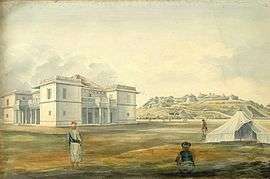Kingdom of Coorg
| Kingdom of Coorg Princely State of Coorg ಕೊಡಗು ಸಂಸ್ಥಾನ | |||||||||
|---|---|---|---|---|---|---|---|---|---|
| 16th century C.E.–1834 | |||||||||
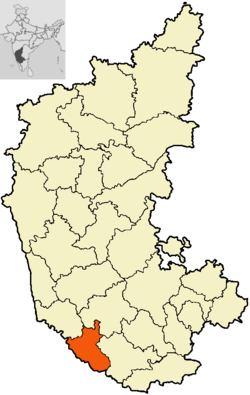 Kingdom of Coorg | |||||||||
| Status |
Kingdom (Subordinate to Kingdom of Mysore between 1780 and 1788). Princely state under the suzerainty of the British Crown after 1790 | ||||||||
| Capital | Piriyapatna, Madikeri | ||||||||
| Common languages | Kodava, Kannada | ||||||||
| Religion | Hinduism | ||||||||
| Government | Monarchy until 1790, Principality thereafter | ||||||||
| Maharaja | |||||||||
| History | |||||||||
• Established | 16th century C.E. | ||||||||
• Disestablished | 1834 | ||||||||
| |||||||||
_-_Copy.jpg)
The Kingdom of Coorg was an independent kingdom which existed till 1834. It was ruled by a branch of the Ikkeri Nayaka. From 1780 to 1788, the kingdom was occupied by neighbouring Mysore but the Rajah of Coorg was restored by the British and became a protectorate of British India on 26 October 1790. In 1834, the then Raja of Coorg rebelled against British authority sparking the Coorg War. The rebellion was brutally quelled by the British who annexed the kingdom and made it a province of British India.
Early history
Although, Rājendranāme, a "royal" genealogy of the rulers of Coorg, written in 1808, makes no mention of the origin of the lineage, its reading by historian Lewis Rice led him to conclude that the princely line was established by a member of the Ikkeri Nayaka family. Having moved south to the town of Haleri in northern Coorg in the disguise of a wandering Jangama monk, he soon began to attract followers; then, with their help, or their acquiescence, he took possession of the town, and in such manner came to rule the entire country.[2] (See Map 11.) According to the genealogy, the Coorg rajas who ruled from the mid-16th century to the mid-18th century were:
| ||||||||||||||||||||||||||||
Muddu Raja, the Coorg ruler from 1633 to 1687, initially ruled from the town of Haleri, but later moved his capital to Mercara, which he fortified and where he built a palace in 1681.[4] Early during the rule of his successor, Dodda Virappa (1687–1736), the army of the neighboring kingdom of Mysore, under the orders of Wodeyar Chikka Devaraja, attacked and seized Piriyapatna, a territory which abutted Coorg (see Map 11), and which was then being ruled by a kinsman of Dodda Virappa.[4] Buoyed by the victory, the Mysore army soon attacked Coorg itself; however, it had advanced only a short distance, when, while camping overnight on the plain of Palupare, it was surprised by a Coorg ambush. In the ensuing massacre, the Mysore army lost 15,000 men, and the survivors had to beat a hasty retreat. For most of the next two decades, the western reaches of Mysore remained vulnerable to attacks by the Coorg army. In the border district of Yelusavira, the Coorg and Mysore forces fought to a stalemate and, in the end, had to work out a tax sharing arrangement.[5]
In 1724, major hostilities resumed between Coorg and Mysore.Changing his modus operandi from guerrilla skirmishes in the hilly Coorg jungle to open field warfare, Dodda Virappa, attacked the Mysore army in the plains. Catching it off guard, he took in rapid succession six fortresses from Piriyapatna to Arkalgud. The resulting loss of revenue, some 600,000 gold pagodas, was felt in Mysore, and several months later, in August or September 1724, a large army was sent from Seringapatam, the Mysore capital, to Coorg.[6] Upon the Mysore army's arrival in the western region, however, the Coorg forces, returning to guerrilla warfare, retreated into the woods. Emboldened by the lack of resistance, the Mysore forces next mounted an attack on the Coorg hills. There too, they met no resistance.[7] However, a few days into this invasion, the Mysore forces, recalling their ignominious ambush in the 1890s, panicked and retreated during the night.[7] Soon, the Coorg army was attacking the Mysore outposts again. This pattern of back and forth was to continue until the Mysore army was recalled, a few months later, to Seringapatam, leaving the region again vulnerable to the periodic raids of the Coorg army.[7] According to historian Sanjay Subrahmanyam,
The entire episode yields a rare insight into one aspect of war in the 18th century: the (Coorg) forces, lacking cavalry, with a minimum of firearms, lost every major battle, but won the war by dint of two factors. First, the terrain, and the possibility of retreating periodically into the wooded hillside, favoured them, in contrast to their relatively clumsy opponents. Second, the Mysore army could never maintain a permanent presence in the region, given the fact that the Wodeyar kingdom had several open frontiers.[8]
The ruler was succeeded by his grandson, Chikka Virappa, whose unremarkable rule lasted until 1768, when Coorg was conquered by Haidar Ali, the new sultan of Mysore.
Later history
In 1780, Coorg was invaded by Hyder Ali of Mysore and the state was annexed. For eight years, Coorg was a part of Mysore. In 1788, through British intervention, the Raja of Coorg regained his kingdom. He signed a treaty bringing Coorg under the protection of the British.
From 1790 to 1834, Coorg remained a protectorate of British India. In 1834, the then Raja of Coorg tried to shake off his allegiance to the British which resulted in the Coorg War. The state was eventually annexed and became the Coorg Province.
Legacy
The present day Madikeri was formerly known as Muddu raja keri (meaning Mudduraja's town) and was named after the prominent king, Mudduraja who ruled Coorg from 1633-1687. The present day Virajpet derived from Virarajendrapete was the town established by Haleri king Dodda Veerarajendra, after whose name the city derives its name.[9][10]
Chikka Virarajendra was the last ruler of Coorg. Kannada litterateur and Jnanpith Award recipient, Masti Venkatesha Iyengar, wrote a critically acclaimed book, Chikavira Rajendra, based on the life and times of that ruler. King Dodda Veerarajendra built the Nalknad Palace.[9]
Gallery
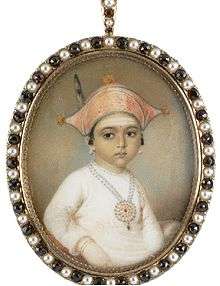 A daughter of Dodda Vira Rajendra
A daughter of Dodda Vira Rajendra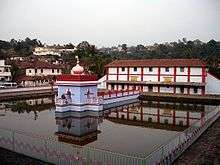 Omkareshwara Temple built by King Linga Raja in Madikeri
Omkareshwara Temple built by King Linga Raja in Madikeri.jpg)
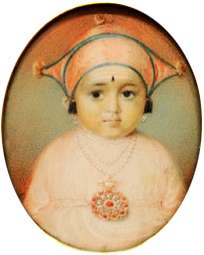 Chikka Vira Rajendra, The last King of Coorg (circa 1805)
Chikka Vira Rajendra, The last King of Coorg (circa 1805)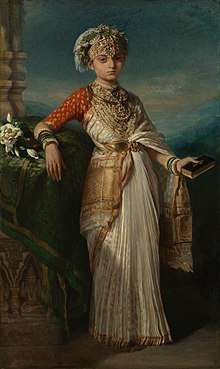 Princess Gouramma, who would later become Victoria Gouramma, the daughter of Chikka Virarajendra, the last king of Coorg, was adopted to be taken care by Queen Victoria.
Princess Gouramma, who would later become Victoria Gouramma, the daughter of Chikka Virarajendra, the last king of Coorg, was adopted to be taken care by Queen Victoria.
References
Citations
- ↑ "Portico of the Coorg Rajah's Palace at Somwaspett". The Wesleyan Juvenile Offering: A Miscellany of Missionary Information for Young Persons. Wesleyan Missionary Society. X: 48. May 1853. Retrieved 29 February 2016.
- ↑ Subrahmanyam 1989, p. 212
- ↑ Rice, Benjamin Lewis (1878). Mysore and Coorg, a gazetteer. p. 100. Retrieved 28 June 2018.
- 1 2 Subrahmanyam 1989, p. 99
- ↑ Subrahmanyam 1989, p. 99
- ↑ Subrahmanyam 1989, pp. 217–218
- 1 2 3 Subrahmanyam 1989, pp. 218–219
- ↑ Subrahmanyam 1989, p. 220
- 1 2 Mookonda, Kushalappa (10 January 2017). "The set-up of Kodagu's royal cemetery". Deccan Herarld. Retrieved 28 June 2018.
- ↑ "On the Haleri trail" (17 August 2009). Deccan Herald. Retrieved 28 June 2018.
Bibliography
- Rice, Lewis (1878), "History of Coorg", Mysore and Coorg, A Gazetteer compiled for the Government, Volume 3, Coorg, Bangalore: Mysore Government Press. p. 427
